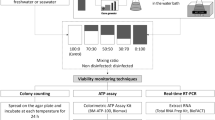Abstract
Plating methods for estimating survival of indicator organisms, such asEscherichia coli, and water-borne pathogens includingVibrio cholerae, have severe limitations when used to estimate viable populations of these organisms in the aquatic environment. By combining the methods of immunofluorescent microscopy, acridine orange direct counting, and direct viable counting, with culture methods such as indirect enumeration by most probable number (MPN) estimation and direct plating, it was shown that bothE. coli andV. cholerae undergo a “nonrecoverable” stage of existence, but remain viable. Following 2-week incubations in saltwater (5–25%o NaCl) microcosms, total counts, measured by direct microscopic examination of fluorescent antibody and acridine orange stained cells, remained unchanged, whereas MPN estimates and plate counts exhibited rapid decline. Results of direct viable counting, a procedure permitting estimate of substrate-responsive viable cells by microscopic examination, revealed that a significant proportion of the nonculturable cells were, indeed, viable. Thus, survival of pathogens in the aquatic environment must be re-assessed. The “die-off” or “decay” concept may not be completely valid. Furthermore, the usefulness of the coliform and fecal coliform indices for evaluating water quality for public health purposes may be seriously compromised, in the light of the finding reported here.
Similar content being viewed by others
References
American Public Health Association (1980) Standard methods for the examination of water and wastewater, 15th ed. American Public Health Association, Inc., Washington, DC
Andre DA, Weiser HH, Malaney GW (1967) Survival of bacterial enteric pathogens in farm pond water. J Am Water Works Assoc 59:503–508
Apel WA, Dugan PR, Filppi JA, Rheins MS (1976) Detection ofThiobacillus ferrooxidans in acid mine environments by indirect fluorescent antibody staining. Appl Environ Microbiol 32:159–165
Baross JA, Hanus FJ, Morita RY (1975) Survival of human enteric and other sewage microorganisms under simulated deep sea conditions. Appl Microbiol 30:309–318
Bireley LE, Buck JD (1975) Microbiology of a former dredge spoil disposal area. Mar Pollut Bull 6:107–110
Bordner R, Winter J (eds) (1978) Microbiological methods for monitoring the environment. EPA 600/8-78-017, US Environmental Protection Agency, Cincinnati
Cherry WB, Goldman M, Carski TR (1960) Fluorescent antibody techniques in the diagnosis of communicable diseases. US Department of Health, Education and Welfare. Public Health Service, Bureau of State Services, Communicable Diseases Center, Atlanta, p 32
Coleman WG Jr, Leive L (1979) Two mutations which affect the barrier function of theEscherichia coli K-12 outer membrane. J Bacteriol 139:899–910
Colwell RR, Kaper J (1977)Vibrio species as bacterial indicators of potential health hazards associated with water. In: Hoadley AW, Dutka BJ (eds) Bacterial indicators/health hazards associated with water. ASTM STP 635, American Society for Testing and Materials, Philadelphia, pp 115–125
Colwell RR, Seidler RJ, Kaper J, Joseph SW, Garges S, Lockman H, Maneval D, Bradford H, Roberts N, Remmers E, Huq I, Huq A (1981) Occurrence ofVibrio cholerae serotype 01 in Maryland and Louisiana estuaries. Appl Environ Microbiol 41:555–558
Costerton JW, Ingram JM, Cheng K-J (1974) Structure and function of the cell envelope of gram-negative bacteria. Bacteriol Rev 38:87–110
Daley RJ, Hobbie JE (1975) Direct counts of aquatic bacteria by a modified epi-fluorescent technique. Limnol Oceanogr 20:875–882
Fliermans CB, Schmidt EL (1975) Autoradiography and immunofluorescence combined for autecological study of single cell activity withNitrobacter as a model system. Appl Microbiol 30:676–684
Francisco DE, Mah RA, Rabin AC (1973) Acridine orange epifluorescence technique for counting bacteria in natural waters. Trans Am Microscopical Soc 92:416–421
Hobbie JE, Daley RJ, Jasper S (1977) Use of nuclepore filters for counting bacteria by fluorescence microscopy. Appl Environ Microbiol 33:1225–1228
Kogure K, Simidu U, Taga N (1979) A tentative direct microscopic method for counting living marine bacteria. Can J Microbiol 25:415–420
LaLiberte P, Grimes DJ (1982) Survival ofEscherichia coli in lake bottom sediment. Appl Environ Microbiol 43:623–628
McFeters GA, Stuart DG (1972) Survival of coliform bacteria in natural waters: Field and laboratory studies with membrane-filter chambers. Appl Microbiol 24:805–811
Mitchell R (1968) Factors affecting the decline of non-marine microorganisms in seawater. Water Res 2:534–543
Reed WM, Dugan PR (1978) Distribution ofMethylomonas methanica andMethylosinus trichosporium in Cleveland Harbor as determined by an indirect fluorescent antibody-membrane filter technique. Appl Environ Microbiol 35:422–430
Schmidt EL, Bankole RD, Bohilool BB (1968) Fluorescent-antibody approach to study of rhizobia in soil. J Bacteriol 95:1987–1992
Singleton FL, Attwell RW, Jangi MS, Colwell RR (1981) Influence of salinity and organic nutrient concentration on survival and growth ofVibrio cholerae in aquatic microcosms. Appl Environ Microbiol 43:1080–1085
Strayer RF, Tiedje JM (1978) Application of the fluorescent-antibody technique to the study of a methanogenic bacterium in lake sediments. Appl Environ Microbiol 35:192–198
Ward BB, Perry MJ (1980) Immunofluorescent assay of the marine ammonium-oxidizing bacteriumNitrosococcus oceanus. Appl Environ Microbiol 39:913–918
Author information
Authors and Affiliations
Rights and permissions
About this article
Cite this article
Xu, H.S., Roberts, N., Singleton, F.L. et al. Survival and viability of nonculturableEscherichia coli andVibrio cholerae in the estuarine and marine environment. Microb Ecol 8, 313–323 (1982). https://doi.org/10.1007/BF02010671
Published:
Issue Date:
DOI: https://doi.org/10.1007/BF02010671




